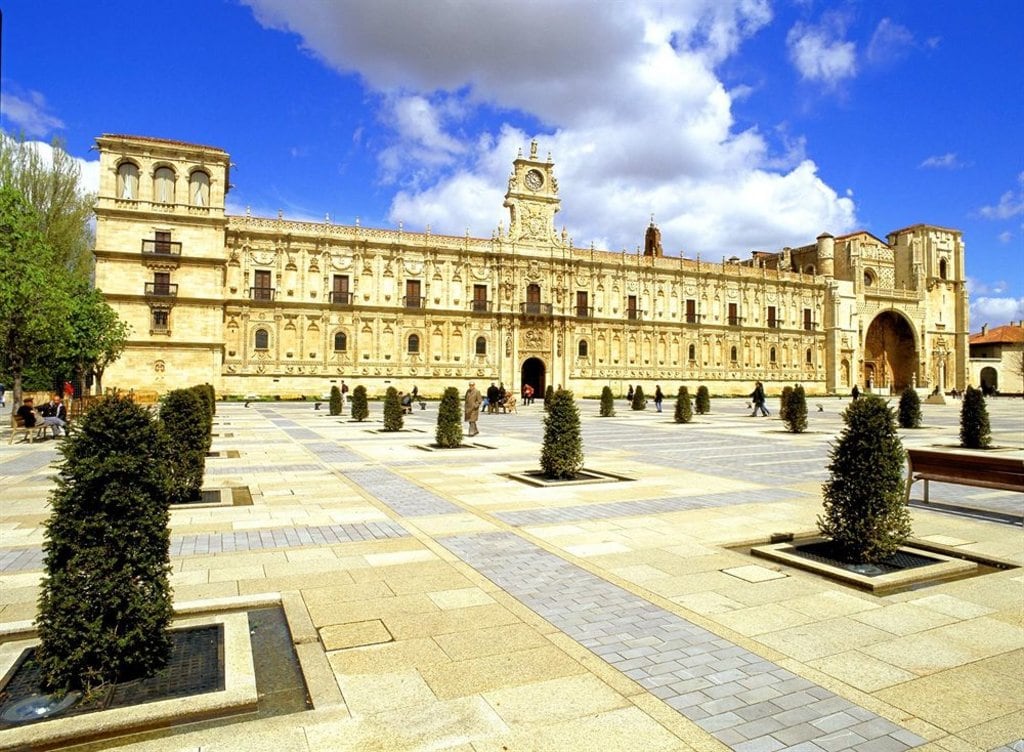Parador Paradise: Monastery Conversions in Spain
“Hotels in historic buildings: it might not sound revolutionary today, but Spain’s parador concept was a seriously forward-thinking tourism initiative when the state launched it with the support of King Alfonso XIII in the 1920s. Paradors are hotels converted from castles, fortresses and other buildings that hold a special place in Spanish history and give you a unique sense of history and prestige in a luxury setting. Many of the best are in the monasteries spread all over the country – formerly home to religious orders, there’s a special kind of hush to these paradors. Here are five monastery conversions where you can enjoy a relaxing stay in Spain – vow of silence optional.
– – – – – –
Parador de Cangas de Onis, Asturias
————————————

Nestled in a bend on the Sella River, Parador de Cangas de Onis is ideal for a quiet rural retreat with some lovely walks nearby; it’s also within striking distance of the Picos de Europa mountains, which give you the option of serious hiking. It’s also a short drive or bus ride to the little valley town of Cangas de Onis, though with the beautiful grounds of this complex (the hotel was a Benedictine monastery built in the Romanesque style), you might not want to leave the hotel.
If you want to see more hotels in Cangas de Onis, visit our Cangas de Onis hotel guide page.
– – – – – –
Parador de Monforte de Lemos, Galicia
————————————–

The Benedictine monastery at San Vicente do Pino was built in the 17th century, although there was a monastery built here centuries before, which was part of a castle complex. Nowadays it’s the Parador de Monforte de Lemos, one of the most scenic high on top of San Vicente hill, giving some incredible views over the town of Monforte de Lemos and the surrounding hills. You get a strong sense that the lofty location would have given the site a suitably monastic hush above the town; today it gives the hotel a feel of relaxed seclusion.
If you want to see more hotels in Lugo, visit our Lugo hotel guide page.
– – – – – –
Parador de Granada, Andalusia
——————————

If it’s about prestige for you, then this is the one – the Parador de Granada is in the grounds of the Alhambra and you can tour the complex starting right from the door of the hotel. One of the finest hotels in Granada, the city’s parador is one of the most popular in the country, thanks not only to its unique location in a UNESCO World Heritage Site, but also its all-round quality, so it’s a good idea to book well in advance. It’s worth the wait though – converted from a monastery built in the palace complex, the parador is extraordinarily well-preserved and has its own museum.
If you want to see more hotels in Granada, visit our Granada hotel guide page.
– – – – – –
Parador de Mérida, Extremadura
——————————-

Mérida, the capital of Extremadura, has a list of historic sites as long as your arm, ranging from prehistoric gold hoards to a huge cluster of Roman monuments and cathedrals in just about every historic architectural style you can name. So you’d rightly expect the city’s parador to be something special; fortunately the Parador de Mérida does the city justice. It’s at once wonderfully preserved, with vaulted ceilings and a beautiful, airy courtyard area, and luxuriously modern, with its outdoor pool and thoughtful décor. Right in the centre of Mérida, it’s ideally placed for exploring the city.
If you want to see more hotels in Badajoz, visit our Badajoz hotel guide page.
– – – – – –
Parador de Leôn, Castile and Leôn
———————————-

The Parador de Leôn is on the city’s impressive Plaza San Marcos and is one of the grandest paradors in the country. Built in the 16th century, the convent of San Marcos de Leon was originally built as a stopping point for pilgrims travelling to Santiago de Compostela and was home to the military-hospitalier Order of Santiago. From the enormous wall tapestries to the artesonado ceilings, carved doors and four-poster beds, it oozes the opulence of Renaissance Spain and feels more like a castle than a monastery. If you’re looking for that sense of wide-eyed historic wonder, you’ll get it here.
If you want to see more hotels in Leon, visit our Leon hotel guide page.“
More Articles With Architecture
All across India you’ll find many grand and impressive buildings that date back to the British Raj and the colonial era, many of which have been transformed into unique hotels. Here are five fascinating examples.
Whether you opt to stay in an inn, a boutique resort or a beachside spa retreat, enjoy the experience of sleeping under a roof of straw at one of these five hotels.
Once the preserve of the most well-to-do Italian families, many former palaces and villas have been converted into stylish, luxury hotels where you no longer need to know the local Count if you fancy a bed for a night.
A little while ago Italy had a problem with abandoned buildings in remote locations. Whole villages, usually in the hills and mountains, were ending up as ghost towns, as inhabitants found it increasingly difficult to make ends meet in these remote spots or just moved away.
Combining modern amenities with a quaint feel and original features, here’s our pick of five historic half-timbered hotels in the UK and beyond.